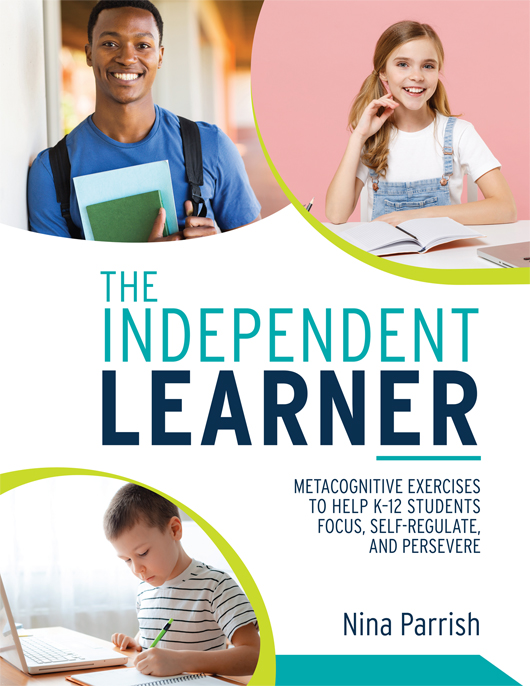Free Reproducibles
The Independent Learner
Metacognitive Exercises to Help K–12 Students Focus, Self-Regulate, and Persevere
Teachers will learn how to promote self-regulation in the classroom with research-based teaching strategies backed by evidence-based pedagogy—all while equipping students with crucial metacognitive models and the ability to take ownership of their learning.
Benefits
- Learn the benefits and components of self-regulated learning
- Encourage students to take ownership of their learning by providing authentic, challenging learning experiences
- Discover numerous research-based strategies and activities that can be used across grade levels and subject areas
- Create an engaging classroom culture that promotes student agency in education
- Receive reproducible tools and educational templates you can use to maximize student learning
Table of Contents
Chapter 1: Metacognition
Chapter 2: Mindsets and Motivation
Chapter 3: Emotional Regulation and Behavior
Chapter 4: Planning, Prioritizing, Organizing, and Managing Time
Chapter 5: Remembering, Understanding, and Applying
Chapter 6: Critical Analysis, Evaluation, and Creative Thought
Epilogue
STUDY GUIDE
REPRODUCIBLES
Chapter 1
- Figure 1.2: Twelve Core Strategies to Encourage Metacognitive Thinking
- Figure 1.3: Thinking About Our Thinking Completed Example
- Figure 1.4: Metacognitive Skills Inventory
- Figure 1.5: My Thinking Changes Over Time
Chapter 2
- Figure 2.1: Growth Mindset Statements
- Figure 2.2: Fixed-Mindset Characterization Example
- Figure 2.4: Creating Hooks Example
- Figure 2.5: SMART Goals
- Figure 2.6: Goal-Achievement Process Plan
- Figure 2.7: Analyzing Graded Assignments
Chapter 3
- Figure 3.1: My Resets
- Figure 3.2: PEACE Mindfulness Strategy
- Figure 3.3: My Suit of Armor
- Figure 3.4: Thoughts, Feelings, Actions, and Results Activity Example
- Figure 3.5: Student-Developed Behavior Goals Example
Chapter 4
- Figure 4.1: Big Rocks, Pebbles, and Sand
- Figure 4.2: Time-Use Analysis With Images
- Figure 4.3: Time-Use Analysis Template
- Figure 4.4: Student-Friendly Learning Objectives Example
- Figure 4.5: Eisenhower Matrix
- Figure 4.9: Student-Created Visual Checklist
Chapter 5
- Figure 5.5: Bloom’s Taxonomy Questions
- Figure 5.7: Prompted and Purposeful Free Recall
- Figure 5.9: Summarizing the Thought Process
- Figure 5.10: I Don’t Get It! Student Feedback Form
Chapter 6
- Figure 6.1: The Four QAR Strategy Question Types
- Figure 6.2: CARE Analysis
- Figure 6.3: KWL Chart With Summary Section
- Figure 6.4: Example Using the Visual Notes, Summary, and Analysis One-Pager Strategy
- Figure 6.5: Storyboard Template
- Figure 6.9: Reciprocal Teaching Student Group Roles
- Figure 6.10: Questions to Determine the Credibility of a Source
SUGGESTED RESOURCES
BOOKS
- Cohen, R. K., Opatosky, D. K., Savage, J., Stevens, S. O., & Darrah, E. P. (2021). The metacognitive student: How to teach academic, social, and emotional intelligence in every content area. Bloomington, IN: Solution Tree Press.
- Conzemius, A. E., & O’Neill, J. (2014). The handbook for SMART school teams: Revitalizing best practices for collaboration (2nd ed.). Bloomington, IN: Solution Tree Press.
- Kise, J. A. G. (2021). Doable differentiation: Twelve strategies to meet the needs of all learners. Bloomington, IN: Solution Tree Press.
- Marzano, R. J. (2017). The new art and science of teaching. Bloomington, IN: Solution Tree Press.
- Porosoff, L., & Weinstein, J. (2018). Empower your students: Tools to inspire a meaningful school experience, grades 6–12. Bloomington, IN: Solution Tree Press.
- Stobaugh, R. (2019). Fifty strategies to boost cognitive engagement: Creating a thinking culture in the classroom. Bloomington, IN: Solution Tree Press.
WEBSITES
Chapter 1
Chapter 2
Chapter 4
Chapter 5
Chapter 6

